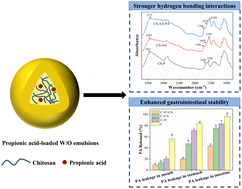Encapsulation of propionic acid within the aqueous phase of water-in-oil emulsions: reduced thermal volatilization and enhanced gastrointestinal stability
Abstract
Propionic acid (PA) is a water-soluble substance that has been shown to be beneficial for improving colon-related diseases. However, its appliance as a nutraceutical ingredient is hampered by its volatility, irritating odor, and easy absorption in the stomach and small intestine. A chitosan solution containing propionic acid was dispersed in a palm oil/corn oil mixture with polyglycerol polyricinoleate (PGPR) to form PA-loaded water-in-oil (W/O) emulsions. The stability of the emulsions was improved by the inclusion of both chitosan and palm oil, where the chitosan reduced the emulsion particle size and palm oil increased the viscosity. The thermal volatility and storage stability of the encapsulated propionic acid were significantly improved due to the stability of emulsion structure and hydrogen bonding between chitosan and propionic acid. Around 56% of propionic acid remained within the aqueous phase after the simulated gastrointestinal digestion. Our results indicate that W/O emulsions might be candidates as colon-targeted delivery systems for propionic acid, which could be beneficial for maintaining colon health.



 Please wait while we load your content...
Please wait while we load your content...